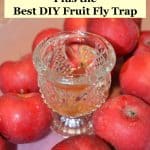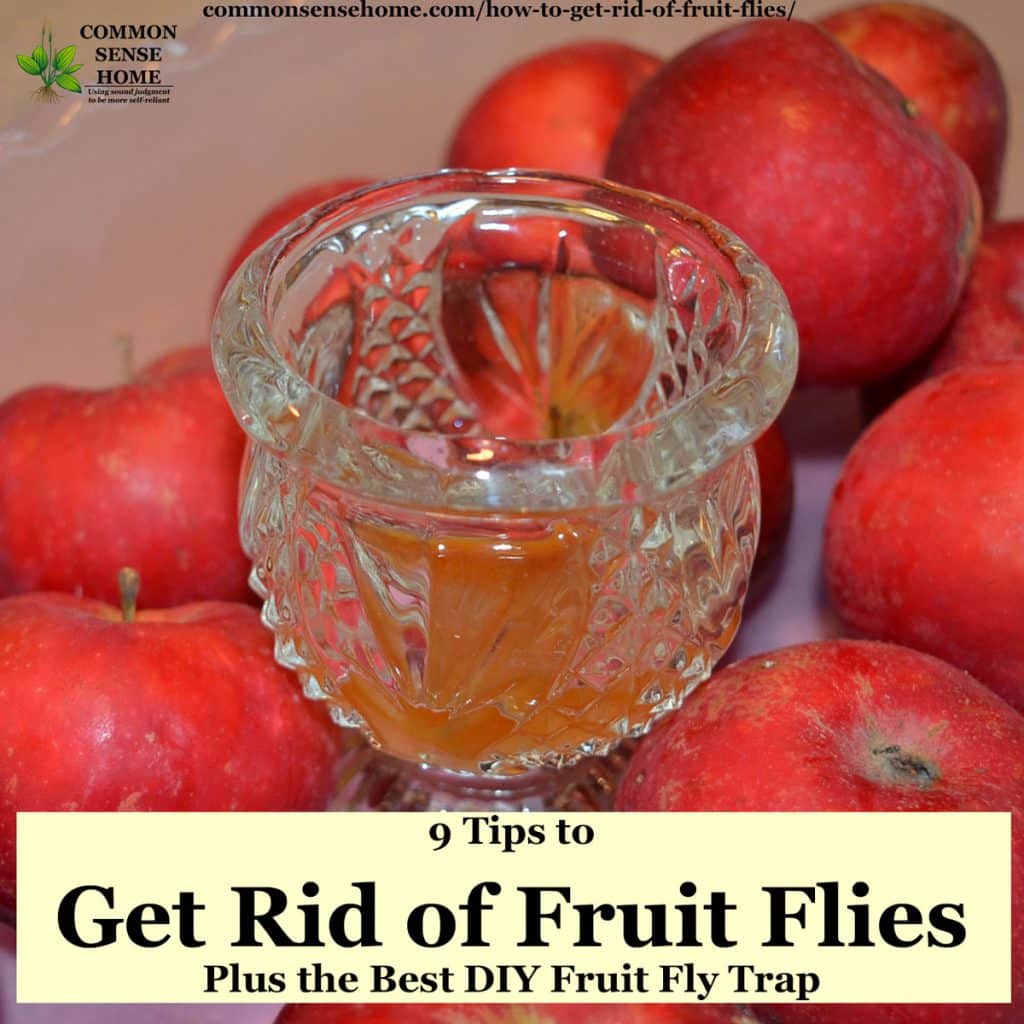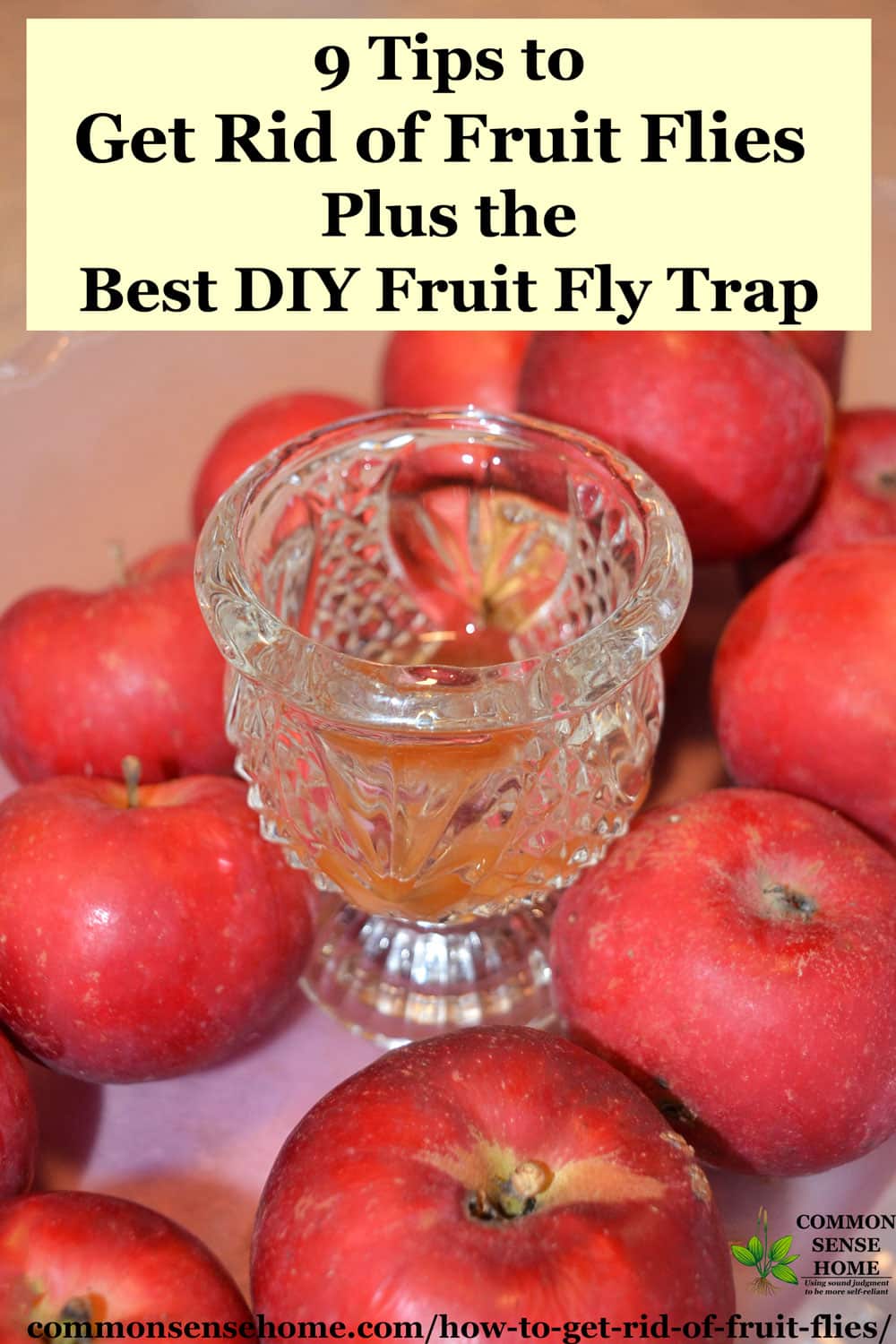How to Get Rid of Fruit Flies (Plus Easy Fruit Fly Trap)
This post may contain affiliate links. Read my full disclosure here.
No one enjoys finding fruit flies or – ew! – even worse, wiggling larva. In this post, I’ll share how to get rid of fruit flies with prevention tips and an easy homemade fruit fly trap to kill fruit flies fast.
Where do fruit flies come from?
As you may have guessed, fruit flies typically come from fruit – or more accurately, from fruit fly eggs laid on fruit. They also lay eggs on other rotting/fermenting produce, in drains, garbage disposals, empty containers, trash, mops and other cleaning supplies. They like booze (yeasty, fruity brews, not hard liquor) and vinegar, too.
Fruit fly eggs are tiny – only about half a millimeter in diameter – so they are not easy to see. They may also be laid inside the produce through cracks or other openings. One female can lay over 500 eggs in her lifetime, and that lifetime is around a week long. You can see how fruit fly numbers increase quickly.
Fruit flies prefer temperatures between 75 and 80°F (24 and 27°C) for egg laying, which means their numbers tend to increase in summer and into fall. Under the right conditions, eggs hatch within 30 hours. Let that overripe banana sit on the counter for a couple of days and BOOM – population explosion.
How to Get Rid of Fruit Flies – 9 Easy Tips
Getting rid of fruit flies works best with a three step approach – keep them out, eliminate breeding areas, and dispatch the fruit flies that are already moved in. We’ll start with steps to keep them out and getting rid of habitat, and wrap up with the cheapest, most reliable fruit fly trap I’ve found to date.
1. Keep Screens on Doors and Windows
It’s great to let some fresh air in, but open unscreened windows invite in pests, including fruit flies. Use screen doors instead of open doors. Make sure all windows and doors are well sealed around the edges, too. (This will also help with your heating and cooling bills.)
2. Wash Produce and Inspect for Damage
When produce comes into the house, you can give it a good wash to help get rid of fruit fly eggs. One simply fruit and veggie wash is one to two cups of white vinegar in a half gallon of cold water. Dip fruit or veggies in the solution, let sit for a few minutes, then scrub gently and rinse with cool water. If fruits or veggies are cracked or damaged, make a note to use those first, and sooner rather than later. Fruit flies and their larva only feed shallowly (they don’t burrow into fruit), so it’s safe to cut off a damaged section and use the rest of the fruit.
Note: Don’t rinse/soak berries or other soft fruit until you’re ready to use them. Too much moisture can lead to spoiling. (See more on berry storage here.)
3. Store Produce in the Refrigerator
You don’t need to get rid of fruit flies if they can’t get in and it’s too cold for them to survive. Cold storage is effective for protecting your produce, but note that it will impact quality of some fruits and vegetables. Watermelons stay sweeter and last longer if they are not kept in cool storage. (Refrigerate just before serving if you prefer cold melon.) Tomatoes convert sugar to starch and become mealy and bland in flavor if kept in cold storage.
4. Clean your Garbage Disposal and Drains
If you have a garbage disposal, it’s easy for it to get coated with a film of food waste, which makes a perfect breeding ground for fruit flies. A simple trick to help clear out your disposal is to dump several trays of ice cubes into into the disposal, followed by some diced lemon peel. You can chase that down with some biodegradable deodorizer, if you’re so inclined. (Note – I prefer composting or vermicomposting to using a garbage disposal if you have the option. Nothing like getting fertilizer for your garden for free!)
Drain pipes can also get covered with a layer of food goo that attracts fruit flies. Try to limit the amount of food that goes down the drain by scraping into the compost instead, and don’t let your dish water sit around until it gets cold. Check the p-trap under your sink if a drain runs slowly, and make sure it’s clear.
5. Wash Dishes Promptly
My old college roommate used to let dishes stack up for a week before she’d wash them. (I took over dish washing.) This is a great way to keep the flies and fruit flies well fed. They especially appreciate wine and juice glasses, or a nice apple core. Remember, eggs hatch in under two days. Get the dishes done before they turn into a fruit fly nursery. Get rid of their food, get rid of fruit flies.
6. Keep Recycling Bins and Trash Cans Clean
“Clean garbage” may sound like an oxymoron, but good sanitation habits apply to trash, too. Food waste or a bit of liquid in the bottom of a bottle is an open invitation to fruit flies. Empty trash cans regularly, and empty and rinse containers before placing them in recycling. If your refuse bins have food spills in them, take them in the shower and give them a scrub.
7. Clean or Replace Your Cleaning Equipment
I’m not a fan of kitchen sponges, because they tend to stay wet – and sometimes breed bacteria. They can also breed fruit flies. Fruit flies like it moist, and they don’t require a lot of food. The residue trapped in a sponge, or a damp dishrag or mop, can be enough to create a breeding spot. Make sure the tools you use to clean are clean and dry when not in use. If a sponge or mop can’t pass the “sniff test” or shows signs of infestation, sanitize it or replace it.
8. Check for Rotten Produce
Fruit flies ALWAYS find the one rotten apple in the bin or bad tomato in the box before I do. Their survival depends on it. You can take this as a curse or a blessing. I treat them as a warning system for fruit gone bad. If I spot a fruit fly homing in on a produce bin, I do an immediate check on the produce. Removing the spoiled fruit helps to protect the rest of the box.
Would you like to save this?
To make it easier to spot produce that’s starting to get past its prime, I store most of my produce in trays or bins that are wider than they are deep. This allows me to see more of the produce at a glance. Stacking fruit and veggies more shallowly also helps to prevent bruising, which can lead to spoilage. Of course, sometimes you need to stack things deeper because of space requirements, but if shallow is an option, I use it.
9. Manage Compost Smartly
If you collect food scraps for compost indoors, make sure your compost bin is tightly lidded. Empty compost regularly, and wash the compost bin. Outside, turning the pile more frequently, and covering food scraps with “browns” like dried leaves, can help keep fruit fly populations down.
The Best Homemade Fruit Fly Trap
I started using this easy homemade fruit fly trap years ago when I noticed the fruit flies going after my apple cider vinegar. When I was researching how to get rid of fruit flies and fruit fly traps, I found that several website confirmed my own findings that this was the more effective DIY fruit fly trap option.
Homemade apple cider vinegar is great if you have it. It’s cheap, and nice and fruity. If you’re buying vinegar, look for real apple cider vinegar (ACV) – not white vinegar with color added. Remember – fruit flies like fruit, the riper and sweeter, the better. If all you can find is white vinegar, you can use that with a little ripe fruit mashed into it, but it doesn’t work quite as well.
To make your homemade fruit fly trap, simply take a small container (I use an old decorative candle holder), and add about a half inch of apple cider vinegar. Next, add a drop of dish soap to the vinegar. That’s it.
The dish soap breaks the surface tension on the vinegar, so the fruit flies fall in and drown. Some people cover the container with plastic wrap with a few small holes punched in, but I don’t find this necessary. Another option is to add a little overripe fruit to the ACV, but sometimes the fruit flies use this for a life boat, so I don’t recommend it.
The photo below shows some fruit flies that were caught in our homemade fruit fly trap. Time to rinse it out and put some fresh vinegar and soap in.
Getting Rid of Fruit Flies for Good
Don’t ever grow or buy any fresh produce, and keep your house meticulously clean, and you can probably avoid fruit flies completely. For my part, I’m not fond of them, but at least I know the produce isn’t coated with so many pesticides that nothing wants to eat it. If your food can sit on a counter for a year or more unchanged (like the infamous happy meal), there are probably better food choices.
To get rid of fruit flies when they do show up, work to eliminate food sources and breeding areas, and set up the fruit fly trap. Without food, they’ll be attracted to the trap, and soon your kitchen will be clear of small flying pests.
You may also find useful:
- Natural Spider Repellents – 8 Ways to Get Rid of Spiders
- The Best Ways to Get Rid of Mice in Your House and Garage
- How to Get Rid of Ants Naturally
- Deer Fly Control and Deterrent Tips to Keep Biting Flies Away
- The Ultimate Guide to Natural Pest Control in the Garden





